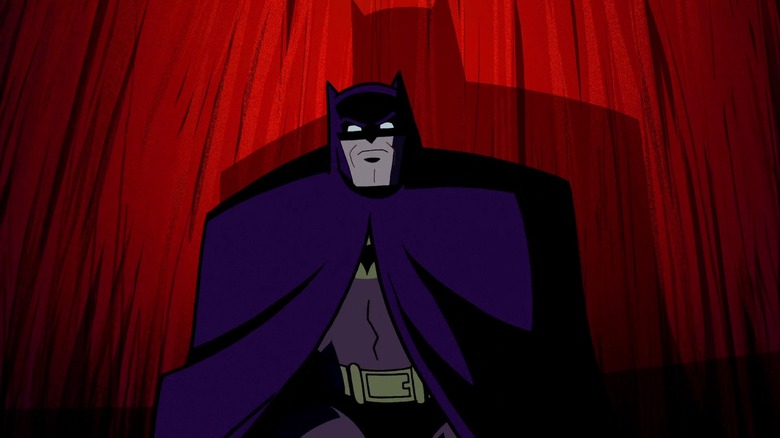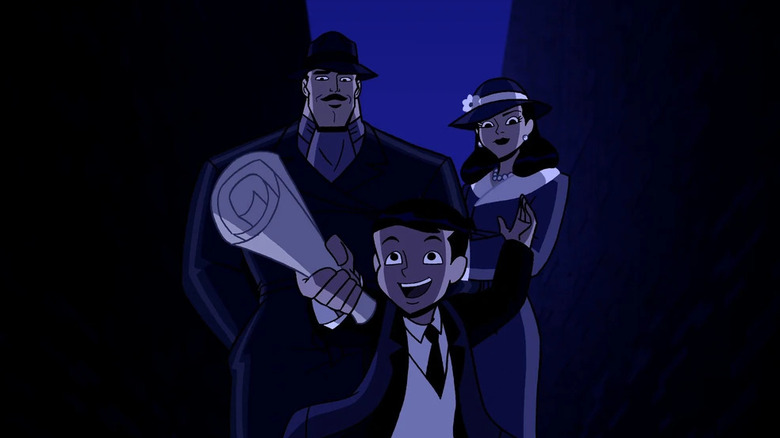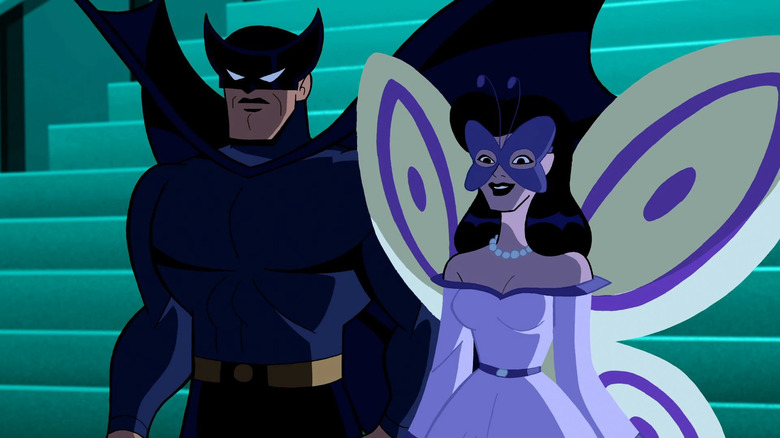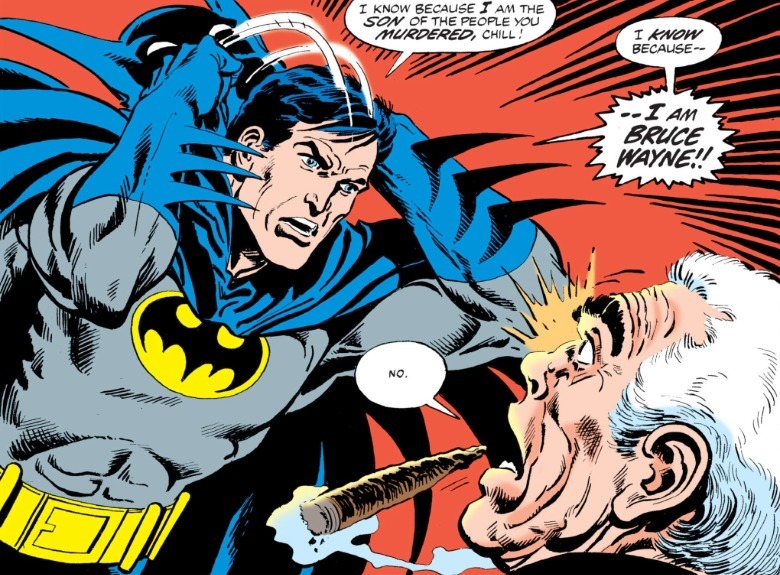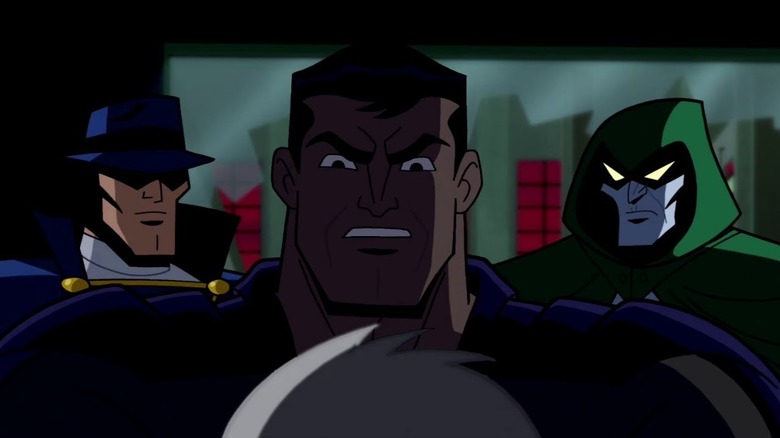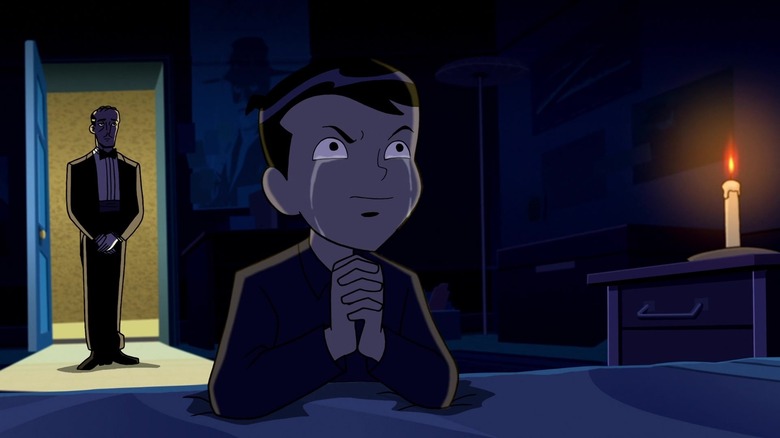One Of The Best Batman Episodes Saw Him Confront His Parents' Murderer
We may receive a commission on purchases made from links.
What is Batman's most famous trait? His black bat costume? His crime-fighting? Or is it his dead parents?
The tragic birth of Batman in Crime Alley, or eight-year-old Bruce Wayne seeing his parents gunned down, has been retold again and again. These days, the story is a ripe target for parody or mockery: "Shouldn't Bruce Wayne just be in therapy!" they (the writers of "Harley Quinn") say, as I point them to Grant Morrison.
But the reason the Wayne murders are constantly featured and referred back to in Batman stories is because it's an innately dramatic and tragic tale, one dripping with pathos, and the cornerstone of Batman's character. Written right, Batman's inability to move past his parents' murder reveals not just his obsessiveness, but his compassion; he can't bring back his parents, so he fights to make sure no one else suffers like he did.
In the classic story "Night of the Stalker" by Steven Englehart and Sal & Vin Amendola (published in "Detective Comics" #439), Batman fails in that. He witnesses a couple gunned down in front of their son, and spends the whole night doggedly tracking the killers to the outskirts of Gotham. Has Batman ever gotten such a confrontation with his own parents' killer? He did so in "Batman: The Brave and the Bold" season 2 episode 11: "Chill of the Night!"
Across "Batman" stories, there isn't total consistency who killed Thomas & Martha Wayne, and why. Sometimes it was a random mugging gone wrong, after which the culprit was caught and identified, as in "Batman Begins." And others, it was a hit and then the gunman vanished into the night never to be found, like in 2022's "The Batman."
"Chill of the Night!" uses the latter option too. But across the episode, Batman (Diedrich Bader) finally learns the killer's identity — Joe Chill (Peter Onorati). That discovery puts Batman to his greatest test yet.
Chill of the Night! was written by prolific Batman writer Paul Dini
"Batman: The Brave and the Bold" is self-admittedly "a lighter incarnation." Its art style and storytelling homages the Silver Age of Comics, with colorful characters, outlandish stories, and a knowing yet sincere sense of humor.
As Batman, Diedrich Bader is imitating Adam West, not Kevin Conroy. Each episode features Batman teaming up with another DC hero, from Aquaman (John DiMaggio) to Blue Beetle (Will Friedle). Batman also fights enemies like Gorilla Grodd (DiMaggio) as much as regulars like the Joker (Jeff Bennett). However, "[Brave and the Bold] is certainly no less valid and true to the [Batman's] roots as the tortured avenger crying out for mommy and daddy," as Bat-Mite (Paul Reubens) declares in "Legends of the Dark Mite!"
Paul Dini, the man who actually wrote those words, later proved "Brave and the Bold" could cling close to the darkness itself. Dini was one of the most acclaimed writers on "Batman: The Animated Series," up-to-then the darkest (and still the best) Batman cartoon. He's also the man who co-created Harley Quinn (voiced originally, and inspired, by his friend Arleen Sorkin).
Even since "Batman: The Animated Series" wrapped, Dini has never really let go of Batman. He even got to pen a run on "Detective Comics" from 2006 to 2009. Dini wrote five "Batman: Brave and the Bold" episodes in total, first "Legends of the Dark Mite!" and then "Chill of the Night!" Does his writing on "Brave and the Bold" measure up to his previous Batman work?
Batman's Silver Age comic book origin, explained
"Chill of the Night!" merges together two Silver Age Batman stories. One is a story from 1948's "Batman" #47 (by Bill Finger and Bob Kane), where Batman confronts the aged Joe Chill, still a criminal and running a trucking company front. Batman unmasks himself in front of Chill, revealing to the man's horror that he created Batman. When Chill deliriously admits he's responsible for Batman's existence, his own infuriated henchmen shoot him dead. The panel of Batman ripping off his mask was recreated, down to the dialogue, by Len Wein & John Byrne in 1980's "The Untold Legend of Batman."
Then, this moment was finally animated in "Chill of the Night!" It's extra impactful in "Brave and the Bold" because it's the first time we ever see the adult Bruce Wayne unmasked in the series.
In 1956, "Detective Comics" #235 (by Finger and Sheldon Moldoff) gave Chill a fuller backstory. Thomas and Martha were attending a costume charity ball. (Thomas was dressed like a bat-man, inspiring his son's later alter ego.) Gangster Lew Moxon was suffering a bullet wound in his shoulder, so he had his crew abduct Thomas, Gotham's finest surgeon. Thomas, still in his bat costume, overpowered the criminals and sent Moxon to jail. A vengeful Moxon then hired Joe Chill to kill the Waynes.
"Chill of the Night!" simplifies it to Moxon and Chill simply robbing the charity ball together. Chill ducks out when Moxon gets arrested; to make it up to his boss, Chill offers to kill Thomas Wayne. In the episode, Batman knows Moxon ordered his parents' death, but not who he ordered. He disguises himself as a priest and visits Moxon on his deathbed to learn the shooter's identity. That then leads into Batman's confrontation with Chill from "Batman" #47 — this time, Chill is an arms dealer selling to Gotham super-villains like Joker and Poison Ivy (Jennifer Hale). It's those costumed criminals that turn on him when he reveals he "created" Batman.
Chill of the Night! is the best Batman: The Brave and the Bold episode
"Chill of the Night!" is obviously about an extremely personal case for Batman. So, wouldn't the team-up format of "Brave and the Bold" work against this episode? Wouldn't shoving in another lead distract from Batman's own story this episode?
You'd think so, but the episode actually does it masterfully. The special guest stars are the mysterious Phantom Stranger and the Spectre, the spirit of vengeance. The two make a wager: the Spectre bets that Batman will submit to revenge and kill Chill, while the Phantom Stranger predicts Batman will hold back and let justice reign. If the Spectre wins, Batman will forever become a murderous agent of vengeance. From there, they hover in the background, sometimes whispering in Batman's ear. Otherwise, Batman's crusade in "Chill of the Night!" is still one man's quest.
This cosmic framing device is an obvious metaphor for the struggle in Batman's soul. If Batman kills Chill, he falls forever. By going back to the case where he first vowed to fight crime, Bruce must ask himself: is his mission about justice, or about vengeance?
"Chill of the Night!" uses some recognizable voices to reinforce the feel of looking back at Batman's history. Kevin Conroy, the most famous Batman voice, voices the Phantom Stranger who is acting as Batman's conscience. Mark Hamill, Conroy's counterpart as the Joker, plays the Spectre as the devil on Batman's shoulder.
Moxon is Richard Moll, who had voiced Two-Face in "Batman: The Animated Series." Thomas and Martha Wayne themselves? None other than Adam West and Julie Newmar (the original Catwoman on the 1966 "Batman.") As different as it is from modern interpretations, "Batman" starring West is when the character became a cultural icon. So, years later, who else could play Bruce Wayne's father?
Chill Of The Night! is one of the best journeys into Batman's wounded heart
The Phantom Stranger and Spectre keep the episode "grounded" (for lack of a better term) in comic book fantasy. They literally transport Batman back to the past so he can get the information he needs; Batman finds himself at that fateful charity ball, and ultimately punches out Moxon alongside his father. (Two Batmen are better than one, I guess.) Such a scene feels at home in "Brave and the Bold," because even the show's darkest episode has to be a little silly.
And "Chill of the Night!" is the darkest episode of the show — literally, as in several scenes have dark lightning and the shadows of a modern Batman story. When Batman confronts Chill, it's in an unlit room. The shadows conceal Batman and he fades into a silhouette. (Batman vanishing into darkness, oh the symbolism!) Diedrich Bader is absolutely fantastic in this scene, reciting the words Bill Finger first wrote decades ago as Batman lets out a lifetime of anger. Again, Bader's Batman is usually more an uptight Caped Crusader, but in this moment, he proves himself a worthy Dark Knight.
Batman spares Chill, but the man still dies, buried under rubble as his warehouse hideout collapses. (Spectre: "I wouldn't know anything about that.") "Chill of the Night!" was never going to end with Batman becoming a murderer, but the episode goes as far as it can to convince you he could. Even if "Batman: The Animated Series" remains the better show overall, "Chill of the Night!" stands next to "Heart Of Ice" or "Joker's Favor" as one of Paul Dini's best Batman episodes.
